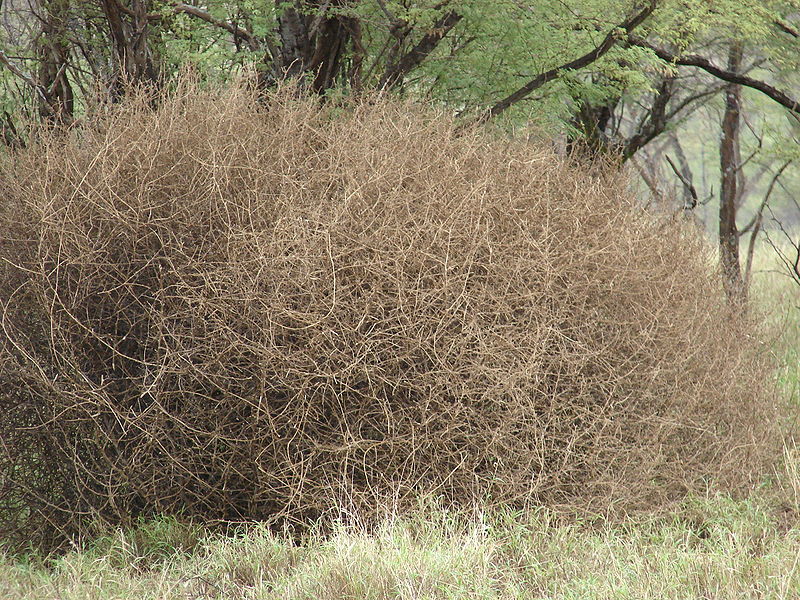Salsola tragus
Russian Thistle
Synonym(s): Salsola pestifer, Salsola iberica, Salsola ruthenica, Salsola kali
Family: Amaranthaceae
Duration and Habit: Summer annual

Photographer: Forest and Kim Starr
Source: http://en.wikipedia.org/wiki/File:Starr_070313-5636_Salsola_tragus.jpg
Description
Russian thistle (Salsola tragus) also referred to as tumbleweed is a summer annual belonging to the family Amaranthaceae. Stems of this plant vary in length from 8 to 36 inches, and are stripped with red or purple markings. Young plants have dark green fleshy leaves that become stiff, shortened, and form a point. Following maturity the plant takes on a dome shape with diameters ranging from 18 inches to 6 feet depending on environmental conditions. During the fall months, the plant becomes dry and breaks off at the soil level where it rolls for great lengths from wind movement. The purpose of the tumbling is to spread seeds across long distances.
Ecological Threat: Russian thistle is a common nuisance in agricultural areas especially in small grain and alfalfa fields. By depleting available water for crops, providing shelter to harmful invertebrates, and a carrier of curly top virus, the Russian thistle reduces crop yield. Facilitated by mode of seed spread, Russian thistle can build up along fence lines where it must be manually removed, creating required labor. Russian thistle is also a fire hazard when accumulated in areas, and is capable of facilitating fire spread when ignited and rolling across the landscape.
Biology & Spread: Seeds are spread after the Russian thistle dries up, breaks off at the soil, and tumbles across the landscape. One plant is capable of releasing 200,000 seeds across several miles depending on wind conditions and path obstructions. Russian thistle seeds are able to rapidly germinate when required temperatures (52o-92o F) and moisture levels are met. Within 12 hours the plantlet within the seed has uncoiled and extended the taproot into the soil. Germination occurs in late winter to early spring when adequate moisture is available for growth. Russian thistle posses another advantage with highly drought tolerant seeds that can extend several feet into the soil to reach ground water.
History: Russian thistle was accidentally introduced to the United States by immigrants in 1873 in contaminated flax seeds brought to South Dakota. Further spread was facilitated by more contaminated flax in railroad cars and natural wind spread of seeds. By 1895 Russian thistle had spread to California and rapidly became established along the west coast.
U.S. Habitat: Russian thistle is most commonly found in disturbed sites such as along roadsides and fences. It can be found in low traffic areas such as vacant lots, non crop fields, poorly tended landscapes, and vegetable crops. Russian thistle is rarely found in well managed landscapes and gardens.
Distribution
Native Origin: Russia
U.S. Present: AL, CA, CT, DC, DE, FL, GA, LA, MA, MD, ME, MS, NC, NH, NJ, NY, OR, PA, RI, SC, TX, VA, VT, WA
Management
Russian thistle can only germinate in loose soil and can't compete with other plants in packed soil. Most home gardens do not require additional herbicide to prevent establishment of Russian thistle. Establishment of Russian thistle in unused areas can be prevented by leaving the soil compacted (avoid discing). Across large landscapes mowing and destroying young Russian thistle plants can be effective in preventing seed dispersal. Herbicide treatments can be used in disturbed areas and crop fields. Young plants should always be targeted first when applying herbicide. Effective preemergent herbicides are: atrazine (Aatrex), bromacil (Hyvar), chlorsulfuron (Telar), hexazinone (Velpar), imazapyr (Arsenal), napropamide (Devrinol), simazine (Princep), and sulfometuron (Oust).
Text References
Whitson, T. D., L. C. Burrill, S. A. Dewey, D. W. Cudney, B. E. Nelson, R. D. Lee, and R. Parker. 2002. Weeds of the West. Jackson, WY: Univ. Wyoming and Western Society of Weed Science.
Internet Sources
 Texas Invasive Species Institute
Texas Invasive Species Institute